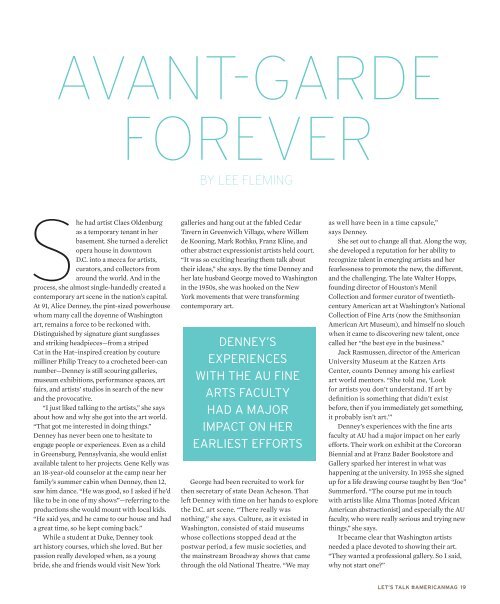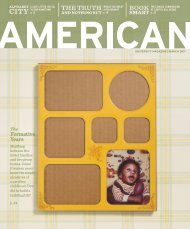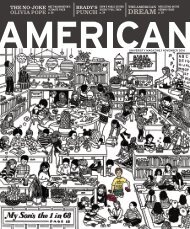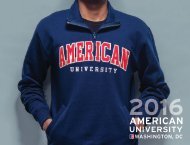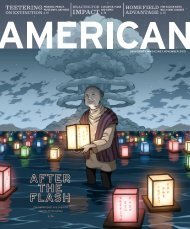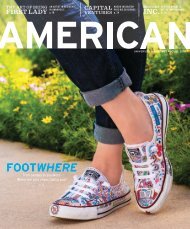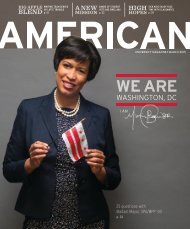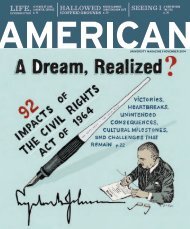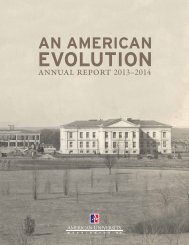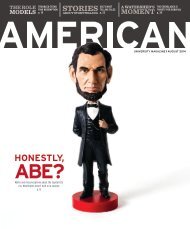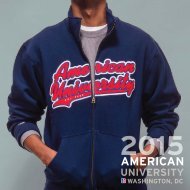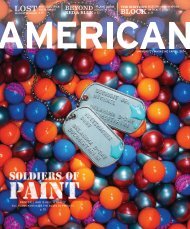You also want an ePaper? Increase the reach of your titles
YUMPU automatically turns print PDFs into web optimized ePapers that Google loves.
BY LEE FLEMING<br />
She had artist Claes Oldenburg<br />
as a temporary tenant in her<br />
basement. She turned a derelict<br />
opera house in downtown<br />
D.C. into a mecca for artists,<br />
curators, and collectors from<br />
around the world. And in the<br />
process, she almost single-handedly created a<br />
contemporary art scene in the nation’s capital.<br />
At 91, Alice Denney, the pint-sized powerhouse<br />
whom many call the doyenne of Washington<br />
art, remains a force to be reckoned with.<br />
Distinguished by signature giant sunglasses<br />
and striking headpieces—from a striped<br />
Cat in the Hat–inspired creation by couture<br />
milliner Philip Treacy to a crocheted beer-can<br />
number—Denney is still scouring galleries,<br />
museum exhibitions, performance spaces, art<br />
fairs, and artists’ studios in search of the new<br />
and the provocative.<br />
“I just liked talking to the artists,” she says<br />
about how and why she got into the art world.<br />
“That got me interested in doing things.”<br />
Denney has never been one to hesitate to<br />
engage people or experiences. Even as a child<br />
in Greensburg, Pennsylvania, she would enlist<br />
available talent to her projects. Gene Kelly was<br />
an 18-year-old counselor at the camp near her<br />
family’s summer cabin when Denney, then 12,<br />
saw him dance. “He was good, so I asked if he’d<br />
like to be in one of my shows”—referring to the<br />
productions she would mount with local kids.<br />
“He said yes, and he came to our house and had<br />
a great time, so he kept coming back.”<br />
While a student at Duke, Denney took<br />
art history courses, which she loved. But her<br />
passion really developed when, as a young<br />
bride, she and friends would visit New York<br />
galleries and hang out at the fabled Cedar<br />
Tavern in Greenwich Village, where Willem<br />
de Kooning, Mark Rothko, Franz Kline, and<br />
other abstract expressionist artists held court.<br />
“It was so exciting hearing them talk about<br />
their ideas,” she says. By the time Denney and<br />
her late husband George moved to Washington<br />
in the 1950s, she was hooked on the New<br />
York movements that were transforming<br />
contemporary art.<br />
DENNEY’S<br />
EXPERIENCES<br />
WITH THE AU FINE<br />
ARTS FACULTY<br />
HAD A MAJOR<br />
IMPACT ON HER<br />
EARLIEST EFFORTS<br />
George had been recruited to work for<br />
then secretary of state Dean Acheson. That<br />
left Denney with time on her hands to explore<br />
the D.C. art scene. “There really was<br />
nothing,” she says. Culture, as it existed in<br />
Washington, consisted of staid museums<br />
whose collections stopped dead at the<br />
postwar period, a few music societies, and<br />
the mainstream Broadway shows that came<br />
through the old National Theatre. “We may<br />
as well have been in a time capsule,”<br />
says Denney.<br />
She set out to change all that. Along the way,<br />
she developed a reputation for her ability to<br />
recognize talent in emerging artists and her<br />
fearlessness to promote the new, the different,<br />
and the challenging. The late Walter Hopps,<br />
founding director of Houston’s Menil<br />
Collection and former curator of twentiethcentury<br />
<strong>American</strong> art at Washington’s National<br />
Collection of Fine Arts (now the Smithsonian<br />
<strong>American</strong> Art Museum), and himself no slouch<br />
when it came to discovering new talent, once<br />
called her “the best eye in the business.”<br />
Jack Rasmussen, director of the <strong>American</strong><br />
University Museum at the Katzen Arts<br />
Center, counts Denney among his earliest<br />
art world mentors. “She told me, ‘Look<br />
for artists you don’t understand. If art by<br />
definition is something that didn’t exist<br />
before, then if you immediately get something,<br />
it probably isn’t art.’”<br />
Denney’s experiences with the fine arts<br />
faculty at AU had a major impact on her early<br />
efforts. Their work on exhibit at the Corcoran<br />
Biennial and at Franz Bader Bookstore and<br />
Gallery sparked her interest in what was<br />
happening at the university. In 1955 she signed<br />
up for a life drawing course taught by Ben “Joe”<br />
Summerford. “The course put me in touch<br />
with artists like Alma Thomas [noted African<br />
<strong>American</strong> abstractionist] and especially the AU<br />
faculty, who were really serious and trying new<br />
things,” she says.<br />
It became clear that Washington artists<br />
needed a place devoted to showing their art.<br />
“They wanted a professional gallery. So I said,<br />
why not start one?”<br />
LET’S TALK #AMERICANMAG 19


